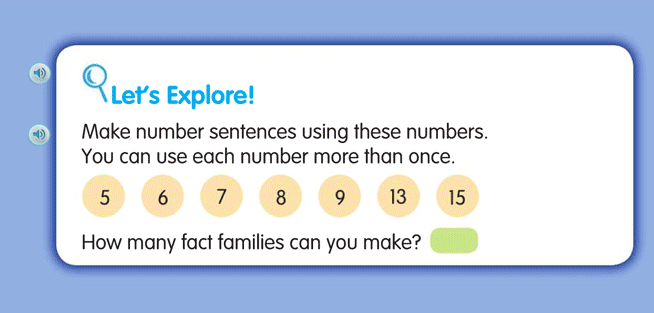
Andy Clark, a thought leader in the Singapore Math model, has recently blogged about two big shifts in mathematical thinking, the first being a problem-solving approach and the second multiple representations.
How do these two approaches facilitate differentiation in your classroom?
This was a question I found myself asking frequently when teaching with the Singapore Math approach. Problem solving can lead to many entry points for differentiating math instruction. Here’s an example from a typical first grade lesson. This problem has multiple solutions.

Struggling Learners: can answer the question, “Can you find one way?”
On-Level Learners: can answer, “Who can find more than one way?”
Advanced Learners: can answer, “How many ways are there to solve this problem and why?”
When students are allowed to answer in multiple ways, they become confident with the math, and might even try to elevate their thinking. So, from the teacher’s perspective, when I come to this type of problem I automatically decide this is a great place for differentiation to occur in my classroom. I don’t have to come up with different activities. The differentiation is built right into the problem-solving pieces. My job becomes knowing what questions to ask. For example: One way? Two ways? Multiple ways? Why or why not?
The next place for differentiation to occur would be in multiple representations. This doesn’t just mean in the lessons when students are using the CPA approach. It could be that they are using those representations when playing a game or completing a hands-on-activity. Let’s take a look at an example from a third grade lesson.

In this example students are supposed to “Roll and Show” 4-digit numbers using base ten blocks.
Struggling Learners: can adapt the number range, use cubes so they can physically put them in groups of tens, show every number rolled.
On-Level Learners: can play the game as intended.
Advanced Learners: can “Roll and Show” the number with base ten blocks, show the number in multiple ways, show the number using only addition, show the number using only tens and ones, and can answer, “How many ways can you show this number?”
If we, as teachers, start looking for opportunities to differentiate using the two approaches—problem solving and multiple representations (CPA)—then during the lesson cycle we will be differentiating for our students. We don’t have to stop, drop, and differentiate every piece of the lesson, because it becomes intuitive. We just need to have the questions ready to ask.
Interested in learning more about the student-centered approach of Singapore Math and going beyond memorization to develop conceptual understanding? Register for our webinar on May 8, “Singapore Math: Moving Beyond Memorization with Math in Focus,” presented by Laura Gifford and Christopher Coyne. They’ll demonstrate how the Math in Focus®: Singapore Math® by Marshall Cavendish® series can enhance and enrich your school’s math framework in order to help teachers and students alike become better critical thinkers and problem solvers.
The views expressed in this article are those of the author and do not necessarily represent those of HMH.

















